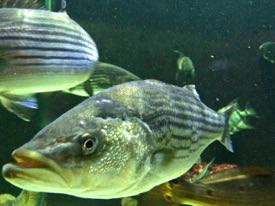VIMS report card: Chesapeake Bay sees smaller than average dead zone in 2022
Duration shortened by cool temperatures, strong winds
The Virginia Institute of Marine Science’s annual report of “dead-zone” conditions in the Chesapeake Bay indicates that hypoxic, low-oxygen conditions were milder than average in 2022. The results concur with a separate report issued by the Maryland Department of Natural Resources in conjunction with the Chesapeake Bay Program.
The dead zone is an area of low oxygen that forms in deep Bay waters when excess nutrients, including both nitrogen and phosphorus, enter the water through polluted runoff and feed naturally occurring algae. This drives the growth of algae blooms, which eventually die and decompose, removing oxygen from the surrounding waters faster than it can be replenished. This creates low-oxygen—or hypoxic—conditions at the bottom of the Bay.
In their 2022 Chesapeake Bay Dead Zone Report Card, VIMS researchers found this year’s dead zone to be the 10th smallest on record since 1985. The Maryland Department of Natural Resources reported the same relative finding based on observations in the mainstem portion of the Bay over the same time period.

Dr. Marjy Friedrichs, a VIMS professor and report card co-author, says "Again, it’s reassuring this year to see that our multiple methods for computing summer hypoxia in the Chesapeake Bay are producing consistent estimates of summer dead zone size. In addition, it's now clear that actions taken by the Chesapeake Bay Program partnership to reduce nutrient pollution are offsetting the increases in hypoxia that would otherwise be occurring due to warming atmospheric temperatures."
These findings are on par with the forecast released in June 2022, which estimated a 13% smaller than average dead zone, predicted as such due to lower amounts of winter and spring precipitation that resulted in smaller river flows that brought fewer nutrient and sediment pollutants into the Chesapeake Bay from its surrounding watershed. This annual forecast is developed by the University of Michigan and informed by data provided by the Chesapeake Bay Program, Maryland Department of Natural Resources, Virginia Department of Environmental Quality, and U.S. Geological Survey.
The U.S. Geological Survey reported that water year 2022 (measured from October 1, 2021—September 30, 2022) had river flows entering the Bay averaging 73,000 cubic feet per second, which is below the long-term water-year average of 79,000 cubic feet per second.
Researchers track Bay oxygen conditions using a variety of methods. Oxygen and nutrient levels are measured as part of the Chesapeake Bay Monitoring Program, a Bay-wide cooperative effort involving watershed jurisdictions, several federal agencies, 10 academic institutions, and more than 30 scientists. Selected partners conducted nine water quality sampling cruises between May—October to track summer hypoxia in the Bay. Results from each monitoring cruise can be accessed through the VECOS website for the Virginia portion of the Bay and the Eyes on the Bay website for the Maryland portion.
Additionally, Friedrichs and Dr. Aaron Bever of Anchor QEA use a computer model combined with local weather information, as well as regular estimates of how many nutrients are entering the Bay from the surrounding watershed, to produce daily real-time estimates of dead-zone size throughout the summer. Their Chesapeake Bay Environmental Forecast System (CBEFS) also provides daily estimates of other environmental conditions throughout the Bay, including water temperature, salinity levels, and acidification.

Weather conditions play a large role in the size and duration of the annual dead zone. Cool and windy conditions in the spring resulted in hypoxia first appearing in June, which is later than the average year. The dead zone then grew to a more typical size through mid-August, due to moderate river flows, temperatures, and winds throughout the region. Hypoxia was still observed in mid-September, but cooler temperatures and stronger winds allowed it to dissipate soon thereafter. In fact, VIMS' models found that the duration of the 2022 dead zone was likely shorter than 95% of any since 1985.
"While it is encouraging to see a smaller dead zone in 2022, we must recognize that it could be even further improved if not for several environmental drivers, such as climate change, increasing populations and stormwater runoff,” said Dr. Kandis Boyd, director of the Environmental Protection Agency’s Chesapeake Bay Program Office. “The partnership is taking actions across the watershed to reduce the flow of nutrient and sediment pollutants from entering the Bay, which not only contributes to improved dissolved oxygen conditions, but also helps to offset the effects of climate change.”

